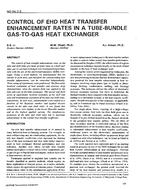Description
The control of heat transfer enhancement rates on the tube and shell sides of a bank of seven tubes in a shell-and-tube, gas-to-gas heat exchanger was investigated experimentally with the use of the electrohydrodynamic (EHD) technique. Using a novel method, it was demonstrated that the current in each tube, and therefore the corresponding heat transfer enhancement, can be controlled independently, Three series of experiments were performed. The first series involved evaluation of heat transfer and pressure drop characteristics when the electric field was applied to the tube side only of the heat exchanger. The second and third series of experiments involved excitation of the shell side only and simultaneous excitation of the tube and shell sides, respectively. In each case, enhancements were studied as a function of the Reynolds number and applied electric current in the tube and shell sides. It was found that enhancements were highest at the lowest Reynolds number and at the highest applied current. The simultaneous excitation of the tube and shell sides led to maximum enhancement in the overall heat transfer coefficient.
KEYWORDS: heat flow, heat exchangers, gas, shell and tube heat exchangers, experiment, calculating, testing, pressure drop, properties, heat transfer coefficient, Reynolds numbers.
Citation: Symposium, ASHRAE Trans. 1994, Vol.100, Part 1,
Product Details
- Published:
- 1994
- File Size:
- 1 file , 880 KB
- Product Code(s):
- D-17767




